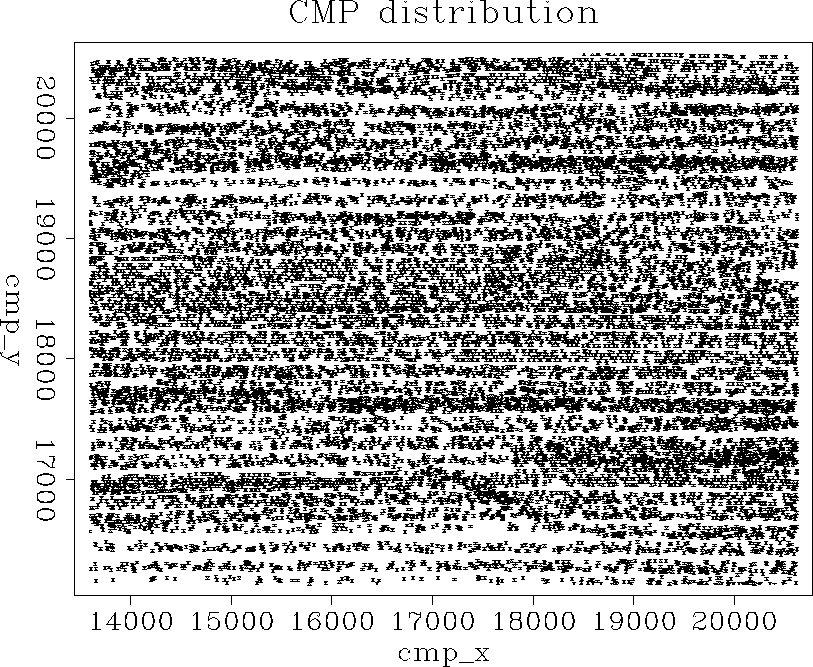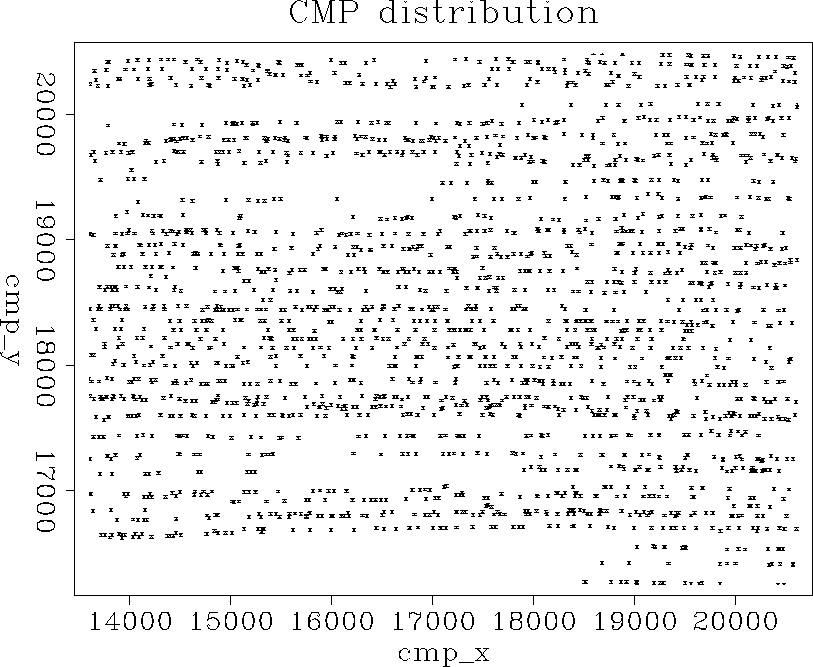




Next: Comparison with previous methods
Up: Introduction
Previous: Introduction
Until recently, conventional seismic exploration techniques
successfully escaped the problem of data regularization.
Two-dimensional seismic exploration (seismic profiling) conveniently
positions seismic sources and receivers at regular locations. Although
the problem of missing data does occur occasionally (missing near
offsets in marine surveys, dead or severely contaminated traces,
etc.), it has only minor importance in 2-D data processing.
The rapid development of three-dimensional seismic methods in recent
years has brought another spatial dimension to the acquisition
patterns. In fact, the data dimensionality has increases by two,
because both the source and receiver locations become two-dimensional
variables in a 3-D seismic setting. The difficulty of acquiring
regularly positioned data has become apparent. An ideal situation,
where both sources and receivers are uniformly distributed on the
surface, almost never occurs in the practice of 3-D exploration. In
typical marine observations, receiver streamers are towed behind a
vessel. This setting leads to an irregular offset-azimuth
distribution. Furthermore, the regularity of midpoint distribution at
large offsets is often affected by cable feathering. On land, there is
more variety in observation systems, but uniform 3-D coverage is
rarely achieved because of practical and economic constraints
Stone (1994).
Figure ![[*]](http://sepwww.stanford.edu/latex2html/cross_ref_motif.gif) shows the common-midpoint (CMP) distribution
for a selected range of offsets in a 3-D marine dataset, acquired in
the North Sea. The CMP distribution looks fairly uniform, but the data
irregularity becomes apparent if we consider an analogous plot for a
selected bin in in-line and cross-line offsets
(Figure
shows the common-midpoint (CMP) distribution
for a selected range of offsets in a 3-D marine dataset, acquired in
the North Sea. The CMP distribution looks fairly uniform, but the data
irregularity becomes apparent if we consider an analogous plot for a
selected bin in in-line and cross-line offsets
(Figure ![[*]](http://sepwww.stanford.edu/latex2html/cross_ref_motif.gif) ). Such irregularities are fairly common in
marine acquisition Biondi (1999). I use this North Sea dataset
for testing data regularization techniques presented in this
dissertation.
). Such irregularities are fairly common in
marine acquisition Biondi (1999). I use this North Sea dataset
for testing data regularization techniques presented in this
dissertation.
cmp-all
Figure 1 Midpoint distribution for a wide range of
offsets in the North Sea dataset.
|
|  |





cmp-win
Figure 2 Midpoint distribution for a 50 by 50 m
offset bin in the North Sea dataset.
|
|  |





The problem of data irregularity in 3-D seismic exploration
manifests itself in different situations. Some of them are
- Kirchhoff prestack migration , the most popular method of
3-D seismic imaging, constructs the image by integrating the input
data over both source and receiver locations
Bleistein (1987). In practice, integration is replaced by
summation over all available data. Data irregularities often
transform into image artifacts Gardner and Canning (1994).
- Multiple elimination is an important processing task in
many regions, where primary reflections are contaminated by
multiples. Some of the most powerful methods of multiple elimination
assume uniform distribution of sources and receivers
Dragoset and Jericevic (1998); Verschuur and Berkhout (1997); Weglein et al. (1997). Data regularization by
interpolating missing data is a necessary step in extending these
methods to 3-D van Dedem and Verschuur (1998).
- Common-azimuth migration is a powerful imaging method,
tailored for narrow-azimuth marine acquisitions
Biondi and Palacharla (1996a); Biondi (1997). Its implementation suggested by
Biondi and Palacharla (1996a) implies that the input data are regularly spaced in
midpoint and offset coordinates and therefore relies heavily on
preprocessing by data regularization. A similar situation occurs in
offset plane wave migration Mosher et al. (1997).
- 4-D seismic monitoring compares 3-D images from repeated
seismic surveys in order to monitor changes in the reservoir
Greaves and Fulp (1987); Lumley (1995). It often requires
co-locating datasets with different acquisition geometries
Legott et al. (1999); Morice et al. (2000). Data regularization onto a uniform grid
provides a method for accurate data matching.
It is important to note that one can use the output of data
regularization consistently for different data processing tasks.
In this dissertation, I focus on a general approach to
three-dimensional seismic data regularization. I address the following
problem: given irregularly spaced data as input, produce a regularly
spaced output that will preserve the essential features of the input.
Although this is a well-known problem in some other Earth sciences
(atmospheric sciences, potential fields, mining and petroleum
engineering), two particular properties of seismic exploration data
require special treatment. First, the extremely large exploration
datasets prohibit computationally expensive methods and require
algorithmic efficiency. Second, multiple coverage makes seismic data
predictable in the offset direction, which can be additionally
explored for optimal results.
The goal of this work is to develop a collection of efficient,
practically affordable numerical methods for data regularization. The
most optimal methods need to be specifically tailored for seismic
reflection data to take advantage of the additional degrees of
predictability that such data possess.





Next: Comparison with previous methods
Up: Introduction
Previous: Introduction
Stanford Exploration Project
12/28/2000
![[*]](http://sepwww.stanford.edu/latex2html/cross_ref_motif.gif) shows the common-midpoint (CMP) distribution
for a selected range of offsets in a 3-D marine dataset, acquired in
the North Sea. The CMP distribution looks fairly uniform, but the data
irregularity becomes apparent if we consider an analogous plot for a
selected bin in in-line and cross-line offsets
(Figure
shows the common-midpoint (CMP) distribution
for a selected range of offsets in a 3-D marine dataset, acquired in
the North Sea. The CMP distribution looks fairly uniform, but the data
irregularity becomes apparent if we consider an analogous plot for a
selected bin in in-line and cross-line offsets
(Figure ![[*]](http://sepwww.stanford.edu/latex2html/cross_ref_motif.gif) ). Such irregularities are fairly common in
marine acquisition Biondi (1999). I use this North Sea dataset
for testing data regularization techniques presented in this
dissertation.
). Such irregularities are fairly common in
marine acquisition Biondi (1999). I use this North Sea dataset
for testing data regularization techniques presented in this
dissertation.

